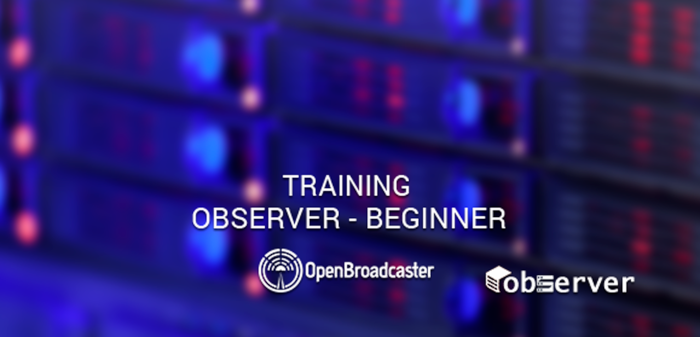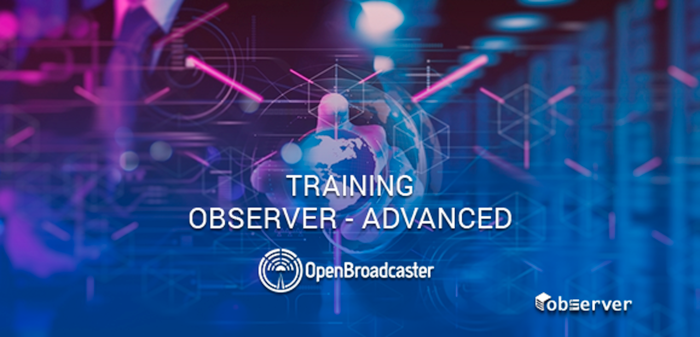


| Learning Outcomes | |
|---|---|
| Outline | How to manage and operate a OpenBroadcaster Observer installation. |
| Skill | Beginner |
| Prerequisites | None |
| Time required | 6 Hours |
| Description | Manage and operate a OpenBroadcaster Observer installation. |
| Challenge | Certificate upon passing grade of 80% of computer administered test. |
Drop any media into Media Player to preview media content
Found on the right side of the screen. Includes: Media Player at the top. Drag media into this space to preview. Selection tabs for Media, Playlists and Programs
Entering info in search bar will give you artist or titles with corresponding words.
Selecting <more at the bottom of the Media Sidebar will expand sidebar toreveal more detail in search results. Selecting the headings will sort alphabetically or numerically. Click again to reverse the selection.
Find by clicking on the admin link on the bottom navigation bar and selecting media settings. Audio formats supported: FLAC (Free Lossless Audio Codec), MP3 (MPEG-1 Layer-3 Audio), MP4 (MPEG-4 Audio), OGG (Ogg Container Format), WAV (Waveform Audio). Video formats supported: AVI (Audio Video Interleave, container format), MPEG (Moving Picture Experts Group), OGG (Ogg Container Format), WMV (Windows Media Video), MOV (Apple Quicktime). Image formats supported: JPEG (Joint Photographic Experts Group), PNG (Portable Network Graphics), SVG (Scalable Vector Graphics)
Found to the left of the search bar. Selected if capitalized. Approved is media that has been approved for play by administrator or other authorized individual. Unapproved is media that awaiting approval by administrator. Archived media is media that is media awaiting deletion or media such as commercials or PSA’s that have been disabled by the AD Manager. Individuals can view and search their own media by selecting MY (media)
Select media from lower navigation bar then select upload media. Click to select files. Will ask where to upload files from. Select single or multiple files for upload. Upload starts automatically and will show progress of each file to 100%. Fill in media information and save. With multiple items of same artist or type, select copy to all to autofill information to all uploads.
OpenBroadcaster supports Media Items embedded with ID3 tags. Once uploaded, select ID3 button to fill in embedded information.
The more details you can add to media when uploaded will give more details for searching. This becomes important as your media library grows.
Found under advanced. Select to display Advance Search box. Search selections are as follows: Artist, Title, Album, Year, Media Type, Category, Country, Language, Genre, Comments and Duration (in seconds). Each primary search parameter has a secondary selection to narrow the search. Select Add to create search criteria.
Public media is any media that can be viewed by anyone using the system. You as an uploader can only view and edit your own private media. We suggest that any media that is approved for play be selected as public so all users of the system can use the common media library. Use the private setting only for media that is personal.
Select Playlist tab from media sidebar to show all playlists. Use search bar to find specific playlists. Highlight selected playlist and right click to edit or show details.
Standard: Basic playlist Advanced: Used for audio,video and pictures running simultaniously. LiveAssist: A playlist that adds multiple internal playlists to act as active buttons.
Public playlists can be viewed by all users but only editable by creator. Private playlists are can only be viewed by the creator.
In the Media Sidebar select playlists. At the bottom of the bar select New. Put your show name in the Name bar and a brief description in the Description bar. Select private or public in the Status bar. Private allows only the creator to see and edit the list, public allows anyone to see the playlist. Under Type select Standard, Advanced or LiveAssist. See Types of Play Lists for more detail. Clear to delete all media from the list, Save to save selections. Note: OpenBroadcaster does not autosave.
Search, select then drag and drop media into Drag Items Here box. Drag media up and down to arrange.
These allow you to program a segment that changes with every play. Start by opening selected playlist then create a search criteria in Advance Search for media. When the search results display select the Add Dynamic Selection button. In the Dynamic Item Properties box create a name for your Dynamic Segment, the number of items to be played (or all) and if an image, the duration. Select Save. Drag and drop segment within the playlist.
Media designated as station IDs once uploaded can be inserted into playlists in two ways. 1.Search for a specific ID and drag and drop into the playlist, or. 2.Create a dynamic segment of many station IDs select admin > player manager and expand, selecting your station.
Providing the user has permission select schedules > schedule shows and if needed select your station from dropdown on the top left. Your schedule is laid out 7 days across by 24 hours down starting the day at 00:00 local time.
Drag and drop a playlist anywhere in the schedule and a dialogue box will open allowing you to schedule it. The box will show the name of the playlist followed by Timeslot - see Assign user to time slot below for detail on selecting other than Manual-, Scheduling Mode or the frequency of play within the schedule, Start Date of playlist, Start Time (Hours, Minutes and Seconds), Duration or the length of the program and Recurring Last Date or when in the future do you want to have this program stop being scheduled. If you get a conflict error message it is because the schedule you have chosen interferes with a previously scheduled program. Contact the admin or program director for details.
This feature is used if a message needs to be announced immediately and/or repeatedly during a specific time period. Providing the user has permission select schedules > priority broadcast. Drag and drop your media into Priority Broadcast page and fill in the dialogue box parameters. Name your priority broadcast, select in seconds, how often this priority will play, Fill in Start and Stop Date and__Time__.
Once set up users will only have to open schedules > schedule shows and drag their playlist into the schedule. At this point they will be prompted to confirm a select date for their show from a dropdown menu.
Go to schedules > schedule permissions and select Add Permissions from the top left of the screen. You will be prompted to select a user from Permission For dropdown menu, Name the show, Scheduling Mode, Start and Stop times, Duration and End Date will be filled out similarly to above Set Start and Stop times option. If you get a conflict error message it is because the schedule you have chosen interferes with a previously scheduled program. Contact the admin or program director for details.
Log out with user and demo adding media with their permissions Admin

| Learning Outcomes | |
|---|---|
| Outline | How to manage and operate Advance OpenBroadcaster server. |
| Skill | Advanced |
| Prerequisites | None |
| Time required | 6 Hours |
| Description | Manage and operate a OpenBroadcaster Advance server. |
| Challenge | Certificate upon passing grade of 80% of computer administered test. |
Advanced Search and filtering
Saved Searches
Default saved searched
Create a Dynamic Playlist based on searches
Viewing extended Metadata
Types of Metadata fields
Create custom metadata fields
Create a Dynamic Playlist based on metadata searches
Add and remove users
Users and Permissions Administration
MOTD (Message of the Day)
Module Management
Add/Delete/Customize Categories and Genres
Create a Permissions Matrix
Logging and Monitoring tool
Device management
Show media formats
Setting up player and Authentication
DPL Default Play Lists
Station IDs attached to Player
Child and Parent Player
Connection Messages
Media Types
Find a bug? Want to request a feature? Submit your issue to OBServer or OBPlayer
Have some Gstreamer, PHP or Python coding skills? Help Contribute and Sponsor to make the OpenBroadcaster community even better
We really appreciate your feedback!